Little girl…little boy. You, the leaf! You, the new branch! Listen to me. Listen to this song I have. A word I have…a speech. You must be dreaming. You must be sleeping. Are you tired? Can I speak to you? Are you tired? Are you dreaming?
I want to talk to you. I have a word from my heart to you. Would you want to talk to me? Would you want to move?
You are the reason my heart is alive! You are the reason my life is complete!
In a lilting voice he gently coaxed then paused, just as his lineage had for centuries. He sought a cue, maybe movement, to let him know he’d made a connection.
From the beginning of March, I’d traveled with Maya Daykeeper Apab’yan Tew to Kansas, Hopi and elsewhere around Arizona. Between journeys I was privileged to host him in my home. Now we were in the last days of the month, he stood—delicately poised in traditional dress, eyes half closed, an arm lifted, hand upturned—at the front of the room. The rest of us seated, in a meditative state.
Huichol composer-musician Xavier Quijas Yxayotl played his flute softly in the background, his music framing Apab’yan’s words. Monita Lynn Baker joined in with just the appropriate bit of percussion. I’d invited Xavier to our Spirit Keepers Series gathering at North Mountain Visitors Center in Phoenix to reconnect with Apab’yan. They hadn’t seen each other in 25 years. Their ritual music-dance teachers were friends but both had long passed.
Apab’yan had spoken at length on K’iche’ Maya worldview—originating from the Guatemalan highlands—and his responsibilities as a Daykeeper working with the Cholq’ij calendar. During the course of the evening he revealed that he’d acted as a traditional midwife for the last 16 years. He had a patient with a difficult pregnancy, the baby in a questionable position, awaiting his return home. This mention naturally led into the singing speech we experienced, the intervention meant to guide the baby to reposition on its own in utero, to align correctly with the birth canal.*
The song ended. The room was silent, the energy palpable. I think we must all have been touched in ways indefinable. Perhaps there was something enlivened that had been asleep. Or a dream grounded into this reality. Perhaps there were aspects we each may have carried into this life from our mothers and fathers—inner vulnerabilities—that were soothed, shed. This was a perfect portal to usher us into the fire ceremony the next day.
North Mountain Visitors Center abuts the Phoenix Mountain Preserve. The beautiful grounds are pristine, belying its poignant past. It was here, from the 1890s until 1930s, that many Native families camped, attempting to see the children taken from their homes and subjected to forced assimilation at the Phoenix Indian School. Interspersed were the tuberculosis camps in the early 1900s for those seeking the curative properties of dry desert air.
We gathered, in the shadows of the small ampitheatre, and Apab’yan consecrated an altar space where he would guide the fire ceremony. And it was here that he would call upon the ancestors. In his own words…
Everything is alive. Everything has a form of communication. Everything has meaning and belongs to a natural system.
The Maya ceremony consists of preparing a ceremonial pyre. It is called a gift but also a payment in the sense of reciprocity. The K’iche’ ceremonial pyre is not a bonfire; it does not burn a long time. It does not need to last. The importance has to do with what happens while the fire is active: There must be a dialogue.
As normal, those assembled took part in the building of the altar, some given special roles. One held the fire stick. Some were called upon to make the first lighting. Two others to pass out candles. And the fire began to burn. Puffing on the ceremonial cigar, Apab’yan called for the Grandmothers-Grandfathers to be present. He made the prayers. Placing candles, we made our own prayers. At long last, the fire started to die down, the conversation coming to completion.
But not yet.
Apab’yan went over to Xavier and Monita, whispering to them. After asking me to lead the circle in holding space, those three walked into the desert. And then…on the air…from the distance…we heard flute and voice rising and falling…singing to the land…to any lingering ghosts of sadness…offering up prayers. And some strange force blew through. It overtook my body. Ever so slowly, involuntarily, my body began to arch backwards until it was in an impossible position. Held. For what seemed like forever. Until it let me go. When I opened my eyes, I saw the Diné woman across the circle crying.
When they re-entered the circle, Apab’yan knelt before her and asked her to ritually bless him with burning sage. That image and the power of it sticks in my mind: Diné woman, Maya man.
The ceremony now closed, the sense of what occurred remained. A communal undertaking. Correctly done. Even as I’m writing this now, I’m feeling into the sacred space…all over again…we all created. I imagine it still hangs in the air in the ampitheatre, the people who pass through wondering what has touched them.
I’ve been in powerful ceremonies before. Fire ceremonies, too. But none ever as compelling as this one. Perhaps it was the culmination of all the energy accumulated from all the ceremonies over a month’s time, carried with us…from Hopi…to private land outside Wichita…to private and public sites in Tucson and finally in Phoenix. And some particularly precious energy remains within my own sanctuary.**
With much respect and gratitude to Apab’yan and those who showed up in these ritual circles. The journey continues in January in Maya Land with the strength we gathered in March. Anyone drawn is welcome.
Below I’m adding a piece written by Pam Hale Trachta with her own reflections.
The Power of Ritual and Ceremony
The smoke from the copal grew thicker in the room, as Apab’yan fed the small container fire with the granules of incense, and his prayers. People seated around him and behind him prayed too, mesmerized now by the hypnotic chanting in the Mayan language, punctuated by English phrases so we could all track where the prayers were being directed.
The room was darkened in order to suggest the atmosphere of the caves where this water ceremony is usually performed. A bowl of water resting on the table received the blessing, and participants would eventually be offered sips of it, as in communion. Finally, roses were dipped into the water and used to shake drops of water on all those gathered.
It was a potent blessing, because the intimacy and power of ritual transcends cultures, language differences and even philosophical details. Spirit is Spirit in any language. And the language of Spirit is ceremony.

Water Ceremony at Tacheria Interfaith School of Spiritual Direction in Tucson. Photo: Pam Hale Trachta.
Read more…
♦♦♦
* Apab’yan Tew is likely the only male Maya midwife that exists. He knows of no other. Indeed, it’s not traditional. It occurred because, when he was a lost young man wandering in the Guatemala highlands, a Maya midwife took him in. And before long he assisted her in the process. He became her apprentice until he began to birth babies on his own. He remains readily sought after as a midwife. When in the highlands he does everything from the beginning: talks, sings, moves and delivers the baby. In the city, he prepares everything until the point of delivery then sends the mother to the hospital for final delivery by a doctor. This was the case recently in Mexico City. Apab’yan and the mother were able to bypass the difficulties of the pregnancy. She successfully delivered a baby girl.
**With many thanks to the following people and organizations for hosting us and making the March beauty possible:
- On Hopi: Charlene and Harold Joseph;
- In Kansas: Lonetta Lollar and John Brack, and Belle Dessa and the Great Plains Earth Institute;
- Elsewhere in Arizona: Pam Hale Trachta, Frank Williams and Tacheria Interfaith School of Spiritual Direction, Leslie Spencer-Snider and North Mountain Visitors Center, and Cindy Heath.








